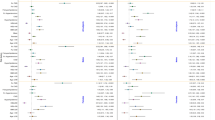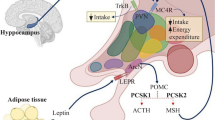Abstract
Obesity is a multifactorial disorder resulting from the interaction between genetic, psychological, physical, environmental, and socioeconomic factors. SIRT1 gene has important effects on the regulation of adiponectin, caloric restriction, insulin sensitivity, coronary atherosclerosis, and cardiovascular diseases. The aim of this study was to investigate the association between childhood obesity and SIRT1 gene polymorphisms regarding rs7895833 A > G in the promoter region, rs7069102 C > G in intron 4, and rs2273773 C > T in exon 5 using PCR-CTPP method in 120 obese and 120 normal weight children. In this study, BMI, systolic and diastolic blood pressure, LDL cholesterol, triglyceride, and insulin levels were significantly higher and HDL-cholesterol levels were significantly lower in obese children compared to normal weight children. For rs7895833 A > G, the rate of having AG genotype and G allele was significantly higher in obese children compared to non-obese group (p < 0.001). The risk for obesity was increased by 1.9 times in G allele carriers; therefore, A allele may be protective against obesity. Both study groups had CT heterozygote genotype for rs2273773 C > T. There was no significant difference for rs7069102 C > G gene polymorphism between groups.
Conclusion: This is the first study reporting an association between SIRT1 gene polymorphisms and obesity in children.

Similar content being viewed by others
Abbreviations
- BMI:
-
Body mass index
- CRTC2 or TORC2:
-
CREB-regulated transcription coactivator 2
- ERF:
-
Erasmus Rucphen Family
- FXR:
-
Farnesoid X receptor
- HDL:
-
High-density lipoprotein
- LDL:
-
Low-density lipoprotein
- LXR:
-
Liver X receptor
- PCR-CTPP:
-
Polymerase chain reaction with confronting two-pair primers
- PGC-1α:
-
Peroxisome proliferator-activated receptor gamma coactivator 1-alpha
- PPARγ:
-
Proliferator-activated receptor gamma
- SIRT1:
-
Silent mating type information regulation 2 homolog 1
- SNP:
-
Single-nucleotide polymorphism
- SREBP:
-
Sterol regulatory element-binding protein
References
Atsuta Y, Hamajima N (2003) A new genotyping method, PCR-CTPP. Rinsho Byori 51:886–891
Atsuta Y, Hamajima N (2011) Improvement on PCR-CTPP: a SNP genotyping approach based on mismatch technique. Yi Chuan 33:182–188
Banks AS, Kon N, Knight C, Matsumoto M, Gutiérrez-Juárez R, Rossetti L, Gu W, Accili D (2008) SirT1 gain of function increases energy efficiency and prevents diabetes in mice. Cell Metab 8:333–341. doi:10.1016/j.cmet.2008.08.014
Birch L, Davison KK (2001) Family environmental factors influencing the developing behavioral controls of food intake and childhood overweight. Pediatr Clin North Am 48:893–907. doi:10.1016/S0031-3955(05)70347-3
Bouchard C (1996) Can obesity be prevented? Nutr Rev 54:125–130
Bundak R, Furman A, Gunoz H, Darendeliler F, Bas F, Neyzi O (2006) Body mass index references for Turkish children. Acta Paediatr 95:194–198. doi:10.1080/08035250500334738
Cakir I, Perello M, Lansari O, Messier NJ, Vaslet CA, Nillni EA (2009) Hypothalamic Sirt1 regulates food intake in a rodent model system. PLoS One 4:e8322. doi:10.1371/journal.pone.0008322
Chong ZZ, Wang S, Shang YC, Malese K (2012) Targeting cardiovascular disease with novel SIRT1 pathways. Future Cardiol 8:89–100. doi:10.2217/fca.11.76
Clark SJ, Falchi M, Olsson B, Jacobson P, Cauchi S, Balkau B, Marre M, Lantieri O, Andersson JC, Jernås M, Aitman TJ, Richardson S, Sjöström L, Wong HY, Carlsson LM, Froguel P, Walley AJ (2012) Association of sirtuin 1 (SIRT1) gene SNPs and transcript expression levels with severe obesity. Obesity (Silver Spring) 20:178–185. doi:10.1038/oby.2011.200
Clarke WR, Lauer RM (1993) Does childhood obesity track into adulthood? Crit Rev Food Sci Nutr 33:423–430
Cole TJ, Bellizzi MC, Flegal KM, Dietz WH (2000) Establishing a standard definition for child overweight and obesity worldwide: international survey. BMJ 320:1240–1243. doi:10.1136/bmj.320.7244.1240
Denis GV, Obin MS (2012) ‘Metabolically healthy obesity’: origins and implications. Mol Aspects Med 34:59–70. doi:10.1016/j.mam.2012.10.004
Drong AW, Lindgren CM, McCarthy MI (2012) The genetic 291 and epigenetic basis of type 2 diabetes and obesity. Clin Pharmacol Ther 92:707–715. doi:10.1038/clpt.2012.149
Drummond EM, Gibney ER (2013) Epigenetic regulation in obesity. Curr Opin Clin Nutr Metab Care 16:392–397. doi:10.1097/MCO.0b013e3283620f45
Haidar YM, Cosman BC (2011) Obesity epidemiology. Clin Colon Rectal Surg 24:205–210. doi:10.1055/s-0031-1295684
Li X (2013) SIRT1 and energy metabolism. Acta Biochim Biophys Sin (Shanghai) 45:51–60. doi:10.1093/abbs/gms108
Li X, Zhang S, Blander G (2007) SIRT1 deacetylates and positively regulates the nuclear receptor LXR. Mol Cell 28:91–106. doi:10.1016/j.molcel.2007.07.032
Miller SA, Dykes DD, Polesky HS (1988) Simples salting-out procedure for extracting DNA from human nucleated cells. Nucleic Acids Res 16:1215
Millington GW (2013) Obesity, genetics and the skin. Clin Exp Dermatol 38:50–56. doi:10.1111/ced.12024
Mutch DM, Clément K (2006) Genetics of human obesity. Best Pract Res Clin Endocrinol Metab 20:647–664. doi:10.1016/j.beem.2006.09.006
Nemoto S, Fergusson MM, Finkel T (2005) SIRT1 functionally interacts with the metabolic regulator and transcriptional coactivator PGC-1{alpha}. J Biol Chem 280:16456–16460. doi:10.1074/jbc.M501485200
Pedersen SB, Ølholm J, Paulsen SK, Bennetzen MF, Richelsen B (2008) Low Sirt1 expression, which is upregulated by fasting, in human adipose tissue from obese women. Int J Obes 32:1250–1255. doi:10.1038/ijo.2008.78
Peeters AV, Beckers S, Verrijken A, Mertens I, Roevens P, Peeters PJ, Van Hul W, Van Gaal LF (2008) Association of SIRT1 gene variation with visceral obesity. Hum Genet 124:431–436. doi:10.1007/s00439-008-0567-8
Picard F, Kurtev M, Chung N, Topark-Ngarm A, Senawong T, Machado De Oliveira R, Leid M, McBurney MW, Guarente L (2004) Sirt1 promotes fat mobilization in white adipocytes by repressing PPAR-gamma. Nature 429:771–776. doi:10.1038/nature02583
PUBMED gene (2014) http://www.ncbi.nlm.nih.gov/gene/23411. Accessed 31 Aug 2014
Purushotham A, Schug TT, Xu Q, Surapureddi S, Guo X, Li X (2009) Hepatocyte-specific deletion of SIRT1 alters fatty acid metabolism and results in hepatic steatosis and inflammation. Cell Metab 9:327–338. doi:10.1016/j.cmet.2009.02.006
Rhee KE, Phelan S, McCaffery J (2012) Early determinants of obesity: genetic, epigenetic, and in utero influences. Int J Pediatr 2012:463850. doi:10.1155/2012/463850
Robinson S, Yardy K, Carter V (2012) A narrative literature review of the development of obesity in infancy and childhood. J Child Health Care 16:339–354. doi:10.1177/1367493512443908
Rodgers JT, Lerin C, Haas W (2005) Nutrient control of glucose homeostasis through a complex of PGC-1alpha and SIRT1. Nature 434:113–118. doi:10.1038/nature03354
Salazar LA, Hirata MH, Cavalli SA, Machado MO, Hirata RDC (1998) Optimized procedure for DNA isolation from fresh and cryopreserved clotted human blood useful in clinical molecular testing. Clin Chem 44:1748–1750
Salminen A, Kaarniranta K, Kauppinen A (2013) Crosstalk between oxidative stress and SIRT1: impact on the aging process. Int J Mol Sci 14:3834–3859. doi:10.3390/ijms14023834
Schug TT, Li X (2011) Sirtuin 1 in lipid metabolism and obesity. Ann Med 43:198–211. doi:10.3109/07853890.2010.547211
Shan T, Wang Y, Wu T (2009) Porcine sirtuin 1 gene clone, expression pattern, and regulation by resveratrol. J Anim Sci 87:895–904. doi:10.2527/jas.2008-1344
Shimoyama Y, Suzuki K, Hamajima N, Niwa T (2011) Sirtuin 1 gene polymorphisms are associated with body fat and blood pressure in Japanese. Transl Res 157:339–347. doi:10.1016/j.trsl.2011.02.004
Tang BL (2011) Sirt1’s systemic protective roles and its promise as a target in antiaging medicine. Transl Res 157:276–284. doi:10.1016/j.trsl.2010.11.006
Turan N, Katari S, Coutifaris C, Sapienza C (2010) Explaining inter-individual variability in phenotype: is epigenetics up to the challenge? Epigenetics 5:16–19
van den Berg SW, Dollé ME, Imholz S, van der A DL, van ‘t Slot R, Wijmenga C, Verschuren WM, Strien C, Siezen CL, Hoebee B, Feskens EJ, Boer JM (2009) Genetic variations in regulatory pathways of fatty acid and glucose metabolism are associated with obesity phenotypes: a population-based cohort study. Int J Obes (Lond) 33:1143–1152. doi:10.1038/ijo.2009.152
Williams K, Thomson D, Seto I, Contopoulos-Ioannidis DG, Ioannidis JPA, Curtis S, Constantin E, Batmanabane G, Hartling L, Klassen T (2012) Standard 6: age groups for pediatric trials. Pediatrics 129:S153. doi:10.1542/peds.2012-0055I
Zillikens MC, van Meurs JB, Rivadeneira F, Amin N, Hofman A, Oostra BA, Sijbrands EJ, Witteman JC, Pols HA, van Duijn CM, Uitterlinden AG (2009) SIRT1 genetic variation is related to BMI and risk of obesity. Diabetes 58:2828–2834. doi:10.2337/db09-0536
Acknowledgments
This study was supported by grants from the University Research Council, Bezmialem Vakif University (BAP: 9.2012/15). The authors would like to thank Assoc. Prof. Dr. Arzu Ergen for her help in this study.
Conflict of interest
The authors declare that there are no conflicts of interest.
Author information
Authors and Affiliations
Corresponding author
Additional information
Communicated by Beat Steinmann
Rights and permissions
About this article
Cite this article
Kilic, U., Gok, O., Elibol-Can, B. et al. SIRT1 gene variants are related to risk of childhood obesity. Eur J Pediatr 174, 473–479 (2015). https://doi.org/10.1007/s00431-014-2424-1
Received:
Revised:
Accepted:
Published:
Issue Date:
DOI: https://doi.org/10.1007/s00431-014-2424-1




